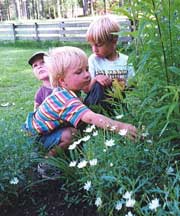
Vol. III, No. 11, November / December 2004
- The Impact of Density and the Definition & Ratio of Activity Centers on Children in Childcare Classrooms
- Early Childhood Facilities Design Institute
- De-Ice, Nicely
- Spending Time In Nature Helps Children with ADHD
- PCB Threat From Caulking
- Vicki Builds a Playground
- Child Care Business Institute
- Recent Projects
Spending Time In Nature Helps Children with ADHD
Parents and teachers may find some help for their children's Attention Deficit with Hyperactivity Disorder (ADHD). Guess what? The answer might be with Mother Nature!
A new study of 452 parents of children with ADHA found that activities in "green" spaces such as farms, parks and even backyards often seemed to temporarily quell the children's symptoms. According to the parent's reports, the children were most likely to show improved symptoms in the hour after an outdoor, green activity than after activity performed indoors or in concrete-and-steel settings.
ADHD is a condition that becomes apparent in some children in the preschool and early school years. It is hard for these children to control their behavior and/or pay attention. It is estimated that between 3 and 5 percent of children have ADHD, or approximately 2 million children in the United States. This means that in a classroom of 25 to 30 children, it is likely that at least one will have ADHD.
 To
see whether green settings might have a more widespread effect, the study's
authors, Drs. Frances E. Kuo and Andrea Farber Taylor of the University
of Illinois at Urbana-Champaign, conducted a national survey that asked
parents to rate how various after-school and weekend activities affected their
children's ability to focus, listen and follow instruction. The study
included families from urban, suburban and rural areas across the United States.
The researchers found that overall, activities in natural settings seemed
to have a calming effect on children. Indoor activities and those in "built"
outdoor settings like parks also seemed to ease ADHD symptoms, but only when
the child was alone or with a friend. In contrast, green activities appeared
to improve symptoms even when a child was part of a large group. Though more
research is needed according to the authors, the findings suggest that green
time could help many children with their inattention and distractibility.
To
see whether green settings might have a more widespread effect, the study's
authors, Drs. Frances E. Kuo and Andrea Farber Taylor of the University
of Illinois at Urbana-Champaign, conducted a national survey that asked
parents to rate how various after-school and weekend activities affected their
children's ability to focus, listen and follow instruction. The study
included families from urban, suburban and rural areas across the United States.
The researchers found that overall, activities in natural settings seemed
to have a calming effect on children. Indoor activities and those in "built"
outdoor settings like parks also seemed to ease ADHD symptoms, but only when
the child was alone or with a friend. In contrast, green activities appeared
to improve symptoms even when a child was part of a large group. Though more
research is needed according to the authors, the findings suggest that green
time could help many children with their inattention and distractibility.
Some past research has also suggested that natural settings help battle so-called attention fatigue in people without ADHD. This temporary fatigue is thought to develop when people have to work to focus their attention on a task, blocking out distractions from their surroundings; the theory is that natural environments provide respite from this effort, according to Kuo and Taylor. Attention fatigue, though fleeing, shares characteristics with ADHD, the researchers note. Some studies, mostly in urban areas, have suggested that spending time in green spaces eases children's ADHD symptoms.
The findings of the study, along with past research, have "exciting implications", according to the study authors. They speculate that daily doses of "green time" such as playing on grass or being in nature could aid in managing ADHD.
So go ahead and build that play garden-the children need it!
Source: American Journal of Public Health, September 2004; Vol. 94
Vol. III, No. 11, November / December 2004
- The Impact of Density and the Definition & Ratio of Activity Centers on Children in Childcare Classrooms
- Early Childhood Facilities Design Institute
- De-Ice, Nicely
- Spending Time In Nature Helps Children with ADHD
- PCB Threat From Caulking
- Vicki Builds a Playground
- Child Care Business Institute
- Recent Projects

